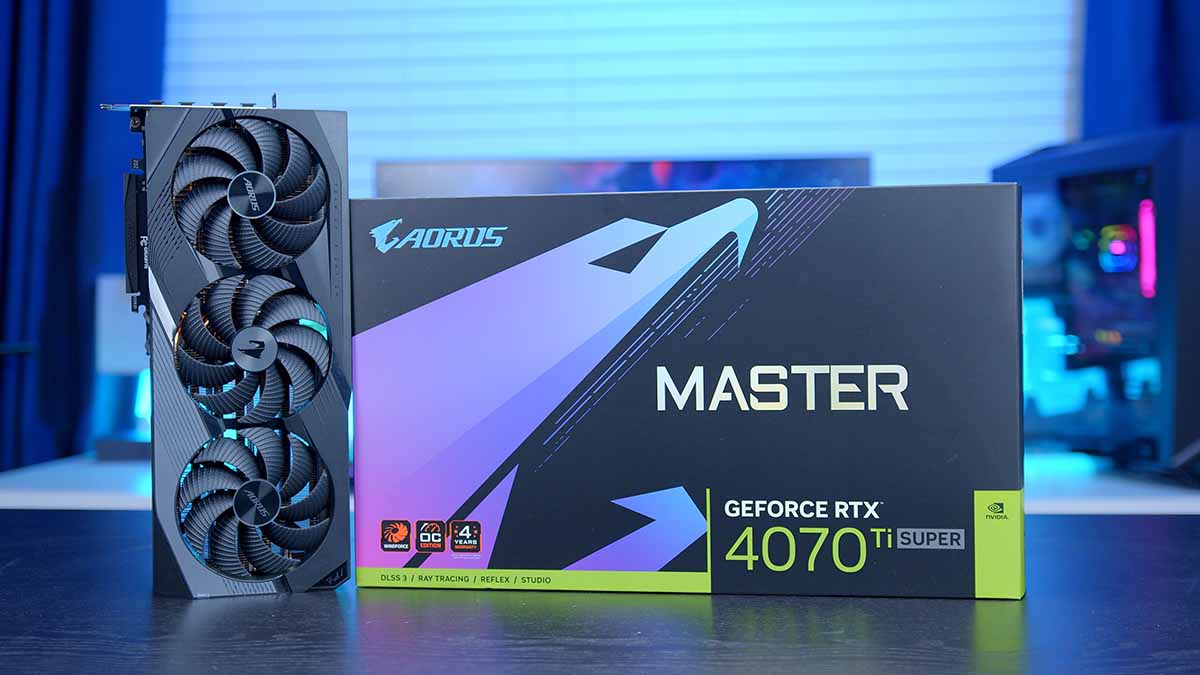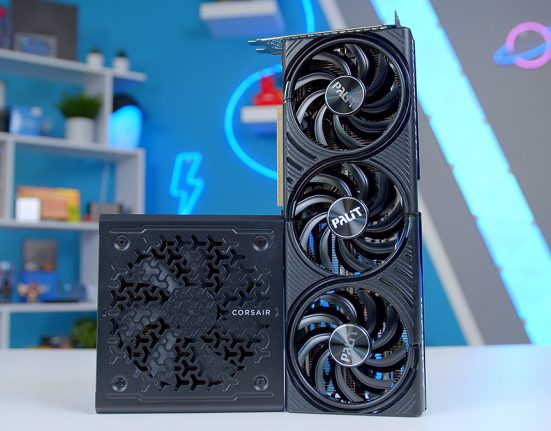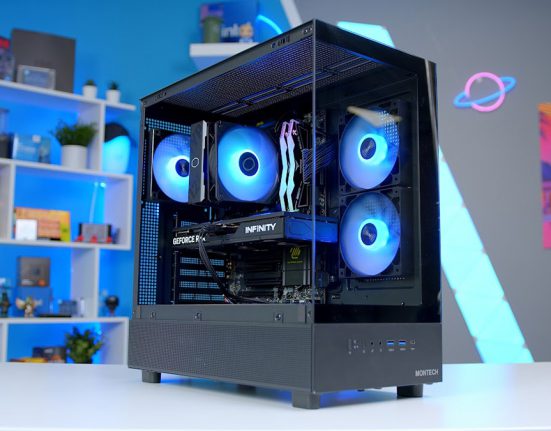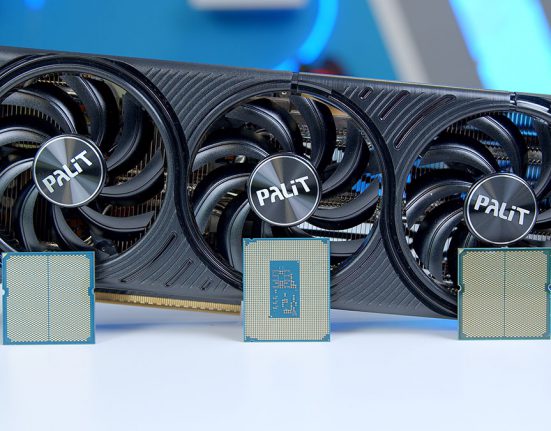The RTX 4070 Ti SUPER is a 1440p capable graphics card from NVIDIA that is part of a mid-life refresh, revitalising three RTX 4000 options. AMD and NVIDIA are in a constant battle to dominate the three main resolutions, with 1440p being particularly popular in light of new games consistently improving visual fidelity and quality.
The RTX 4070 Ti is the second card to launch amongst the ‘SUPER’ refreshes, hitting the market directly a week after the RTX 4070 SUPER. This card also released alongside the RTX 4080 SUPER, which is the final GPU to drop in the SUPER range. NVIDIA’s Ada Lovelace-based cards have a very solid foundation in terms of the architecture, so it makes sense that NVIDIA would look to reinvigorate their current line-up to compete against AMD.
In this review, we’ll be doing a deep dive on the Gigabyte AORUS Master variant of the RTX 4070 Ti SUPER, with an assessment of the performance and value that this card offers versus the competition.
Specifications
The RTX 4070 Ti SUPER offers a number of hardware improvements when compared to the vanilla RTX 4070 Ti model, the biggest of which are VRAM capacity and the memory bus bandwidth. In a market where VRAM has seemingly become one of the most important factors that determine how fast your game will run, the 4GB increase in VRAM up to 16GB is a welcome change.
I’d argue that 10GB is the minimum requirement for most modern titles, but the 16GB on the RTX 4070 Ti SUPER improves general gaming performance, while providing more longevity in AAA games. The 256-bit memory bus also provides more bandwidth, further enhancing performance.
The smaller upgrades come in the form of core count increases, with CUDA cores receiving around a 10% rise up to 8448 from 7680. Both RT and Tensor cores have also been bumped up slightly with a small rise up to 66 and 264 respectively. Despite being upgraded quite significantly, power draw has not changed, which is impressive considering how much has been altered from the original RTX 4070 Ti.
| Specification | Gigabyte AORUS RTX 4070 Ti SUPER Master |
|---|---|
| Video Memory | 16GB GDDR6X |
| Memory Bus | 256-bit |
| Core Clock Speed | 2.34GHz |
| Boost Clock Speed | 2.67GHz |
| CUDA Cores | 8448 |
| RT Cores | 66 |
| Tensor Cores | 264 |
| Power Consumption | 285W |
| GPU Length | 342mm |
| MSRP | $799 |
As a brief note, boost clock speeds of this card will differ by a fair margin depending on the model. The RTX 4070 Ti does not have a Founders Edition model, so some of the alternative cards are likely to see some form of overclock to the boosting capability. Generally, the non-OC model cards will have a baseline boost clock speed, and are normally cheaper than their OC counterparts.
| Spec | RTX 4070 Ti | RTX 4070 Ti SUPER | RTX 4080 |
|---|---|---|---|
| Video Memory | 12GB GDDR6X | 16GB GDDR6X | 16GB GDDR6X |
| Memory Bus | 192-bit | 256-bit | 256-Bit |
| Core Clock Speed | 2.31GHz | 2.34GHz | 2.21GHz |
| Boost Clock Speed | 2.61GHz | 2.61GHz | 2.51GHz |
| CUDA Cores | 7680 | 8448 | 9728 |
| RT Cores | 60 | 66 | 76 |
| Tensor Cores | 240 | 264 | 304 |
| Power Consumption | 285W | 285W | 320W |
| MSRP | $799 | $799 | $1199 |
RTX SUPER Cards – What Are They?
The refresh of the RTX 4000 range of cards is not the first ‘SUPER’ rebranding that we’ve seen from NVIDIA. Back in July of 2019, after the launch of the initial RTX 2000 series, NVIDIA refreshed three of their cards with some mid-life hardware improvements. The RTX 2060, RTX 2070, and RTX 2080 all saw SUPER rebrands, but NVIDIA has changed tactics with the RTX 4000 range of cards.
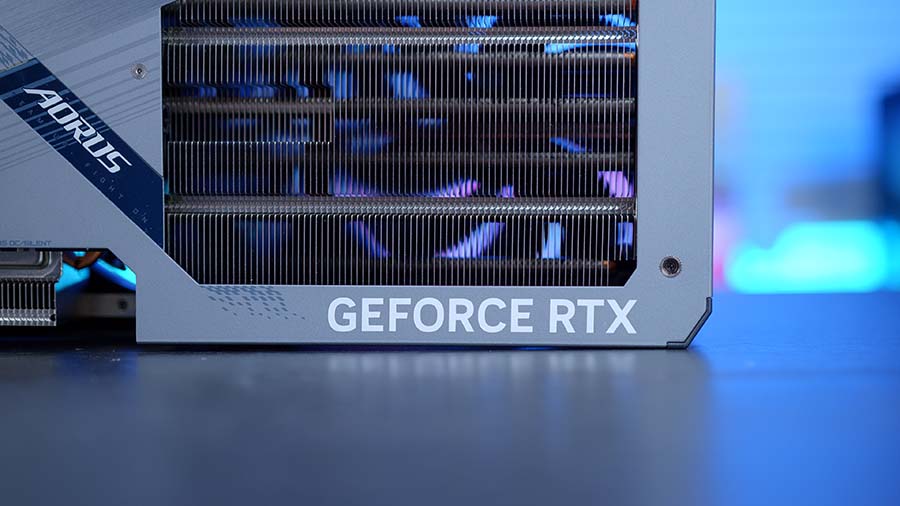
Instead of the RTX 4060 receiving some upgrades, this has been switched out for the more top-end ranges, with the RTX 4070, RTX 4070 Ti, and RTX 4080 all getting a SUPER update. The main changes being made to these cards are hardware enhancements, but there have been some pricing adjustments too.
The RTX 4070 SUPER and RTX 4070 Ti SUPER cards sit at the same price as their predecessors. On the other hand, the RTX 4080 SUPER drops down to $999 to compete with the likes of the RX 7900 XTX from AMD.
| Model Name | MSRP |
|---|---|
| RTX 4060 | $299 |
| RTX 4060 Ti 8GB | $399 |
| RTX 4060 Ti 16GB | $499 |
| RTX 4070 | $549 |
| RTX 4070 SUPER | $599 |
| RTX 4070 Ti | $799 |
| RTX 4070 Ti SUPER | $799 |
| RTX 4080 | $1199 |
| RTX 4080 SUPER | $999 |
| RTX 4090 | $1599 |
The standard RTX 4070 has also seen a small pricing change to $549, likely in an attempt to combat the RX 7800 XT, which comes in at the $499 mark. Overall, the prices and hardware changes are promising. NVIDIA received a significant amount of flack during the initial launches of RTX 4000 cards, so an adjusted set of prices will recoup favour among many buyers.
Design
On the design front, Gigabyte’s AORUS Master version of the RTX 4070 Ti SUPER is one of the flashiest cards on the market. This GPU is geared towards enthusiasts that aren’t worried about having to spend some extra cash on their graphics card. The Gigabyte AORUS RTX 4070 Ti SUPER Master is a triple-fan option, utilising Gigabyte’s renowned WINDFORCE cooling system.
Thermal performance is extremely strong thanks to the large vapour chamber, mass of heatpipes, and three 108mm fans designed to push air effectively and dissipate heat efficiently. During our testing, we found that the Gigabyte AORUS Master variant of the RTX 4070 Ti SUPER was one of the most thermally capable cards when compared to other versions.
In terms of aesthetics, this RTX 4070 Ti SUPER sports a futuristic heatsink shroud with various etchings across the front of the card. Each of the fans offers a ring of RGB lighting, which sits around the edge of the cut-out. The RGB on the front of the card looks awesome, and isn’t too crazy. It provides some additional flair without taking away from the dark theme of the card.
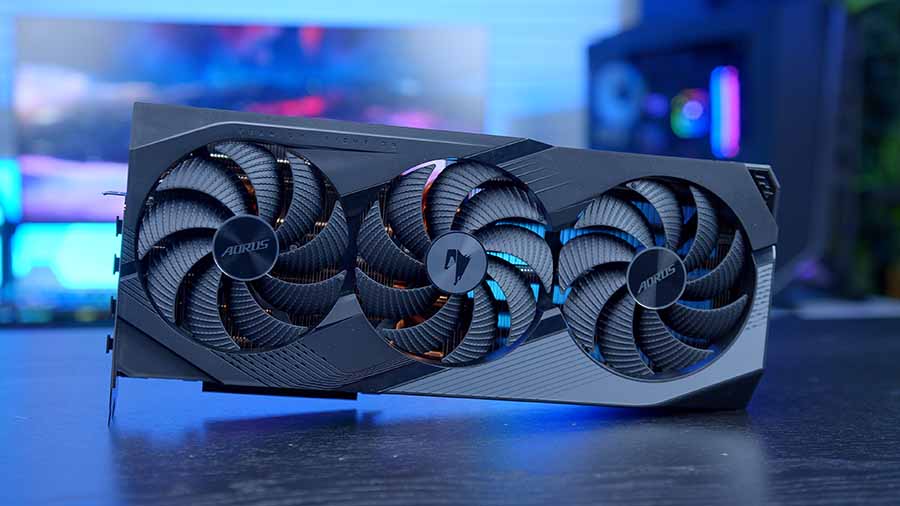
You’ll also find additional RGB on the top, and back of the Gigabyte AORUS Master variant. This means that whichever way you’ve decided to install and mount your GPU, there will always be some visible lighting, which can be fully customised within Gigabyte’s RGB Fusion software.
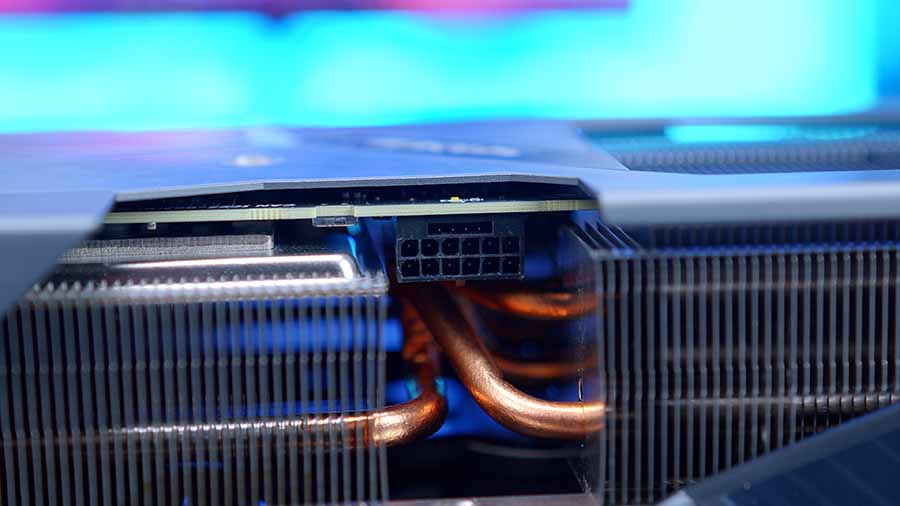
The backplate of this card does shift the colour scheme slightly. Instead of a dark black style, the backplate is more of a silvery-grey tone featuring some AORUS logos. While some buyers might not be a fan of the contrasting colour, I’m a big fan of the look.
The addition of the heatsink peering through the backplate adds another element of depth to your build, while also assisting airflow. Overall, the Gigabyte AORUS RTX 4070 Ti SUPER Master is a great looking card geared towards enthusiasts that are looking to spice up the look of their system.

Performance
To ascertain how well the Gigabyte AORUS RTX 4070 Ti SUPER Master performs, our in-house benchmarker, Harry Coleman, has put this Gigabyte variant through the wringer with a plethora of gaming benchmarks. We’ve run a plethora of different games to see how this card holds up against other RTX 4070 Ti SUPER options, along with competitor cards too. The table below is also worth taking a look at as it highlights worthwhile cards to keep an eye out for.
| GPU Name | Availability |
|---|---|
| AMD Radeon RX 7800 XT | $499 |
| NVIDIA RTX 4070 SUPER | $599 |
| NVIDIA RTX 4070 Ti | $799 |
| NVIDIA RTX 4070 Ti SUPER | $799 |
| AMD Radeon RX 7900 XT | $749 |
Alan Wake 2
Settings: 1440p, Post-Processing High, Texture Resolution High, Texture Filtering High, Volumetric Lighting High, Global Illumination Quality High, Shadow Detail High, Terrain Quality High, Ray-Tracing: Disabled, DLSS: On/Off, Frame Generation: On/Off
In Alan Wake 2 at 1440p high, we ran two separate benchmarks. One with DLSS and ray tracing, and one without. With these settings switched off, the RTX 4070 Ti SUPER was able to offer an 85FPS average, which for the most part was relatively smooth. Alan Wake 2 is quite intensive and not very optimised, so its great to see that we were sitting well above the 60FPS mark.
Compared to other cards that we’ve tested, the RTX 4070 Ti SUPER offers a 11FPS increase over the standard RTX 4070 Ti, and a 16FPS boost versus the RTX 4070 SUPER. Framerate differences are more noticeable at this level due to the lower averages, so higher really is better.
With ray tracing and DLSS enabled, the RTX 4070 Ti SUPER saw an average FPS of 119. DLSS is putting in a huge amount of work here, but the visual fidelity improvement with ray tracing switched on was great to see, and overall gameplay was very smooth.
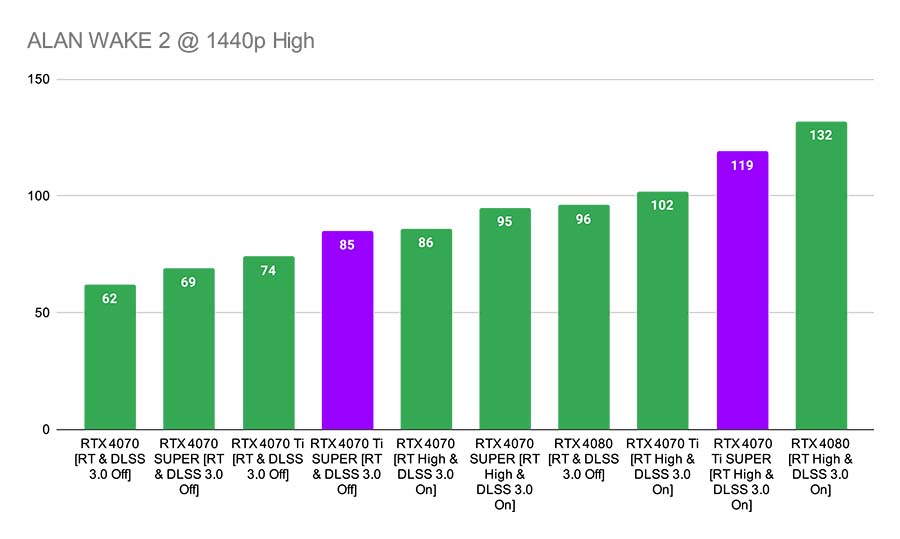
Starfield
Settings: 1440p, Shadow Quality High, Indirect Lighting High, Reflections High, Crowd Density High, Particle Quality High, Volumetric Lighting High, Motion Blur off, GTAO Quality High, Grass Quality High, Contact Shadows High VSync Off, DLSS/FSR OFF
Starfield is another title that can be quite demanding, for this reason modern cards can struggle from time to time. Despite this, the RTX 4070 Ti SUPER pushed through, offering a very smooth 98FPS average. The RTX 4070 Ti SUPER aligns quite closely with the RX 7900 XT which saw an average framerate of 103FPS (a 5 frame increase to be exact).
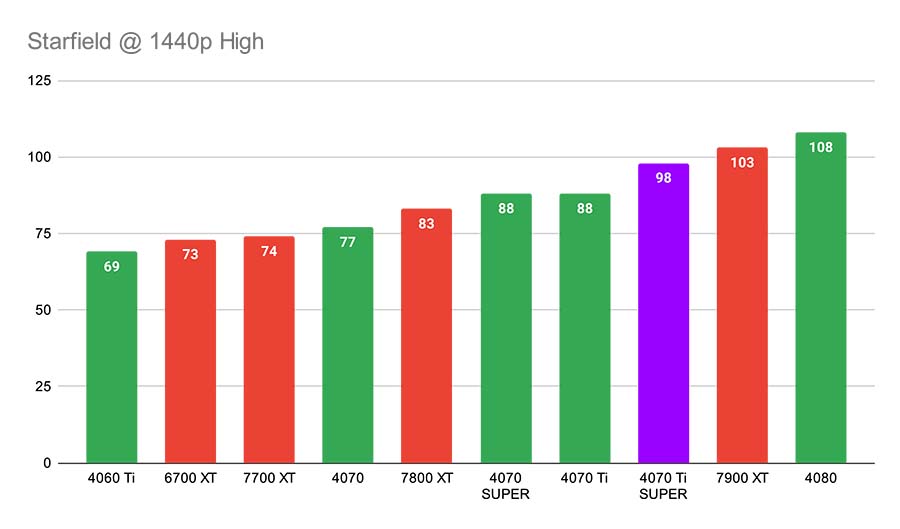
Cyberpunk 2077
Settings: 1440p, Shadow Quality High, Indirect Lighting High, Reflections High, Crowd Density High, Particle Quality High, Volumetric Lighting High, Motion Blur off, GTAO Quality High, Grass Quality High, Contact Shadows High VSync Off, DLSS/FSR: On/Off, Ray Tracing: On/Off, Textures: High
In Cyberpunk 2077 with ray tracing and DLSS turned on, the RTX 4070 Ti SUPER sat around 103FPS on average, which was more than playable. Cyberpunk 2077 is a very demanding title, so the increase in VRAM is a huge bonus for this game.
With NVIDIA’s pillar technologies turned off, the RTX 4070 Ti SUPER was able to outpace the RX 7900 XT. It is clear that the increase in CUDA and Tensor cores was definitely worth it for this card, making higher framerates more achievable within intensive games.

Hogwarts Legacy
Settings: 1440p, Shadow Quality High, Indirect Lighting High, Reflections High, Crowd Density High, Particle Quality High, Volumetric Lighting High, Motion Blur off, GTAO Quality High, Grass Quality High, Contact Shadows High VSync Off, DLSS/FSR: On/Off, Ray Tracing: On/Off, Textures: High
Hogwarts Legacy is another AAA title that prioritises visual fidelity and is one of the best looking titles within our benchmarking suite. For this reason, it is quite a demanding game, but the RTX 4070 Ti SUPER impressed us with a 117FPS average. This GPU sat towards the top of our benchmarking graph beating out the RX 7900 XT with a 2FPS gain.
Performance was very close between most of the cards that we’ve tested in this benchmark, but the RTX 4070 Ti SUPER is a clear winner for those looking to max our their framerates at 1440p.
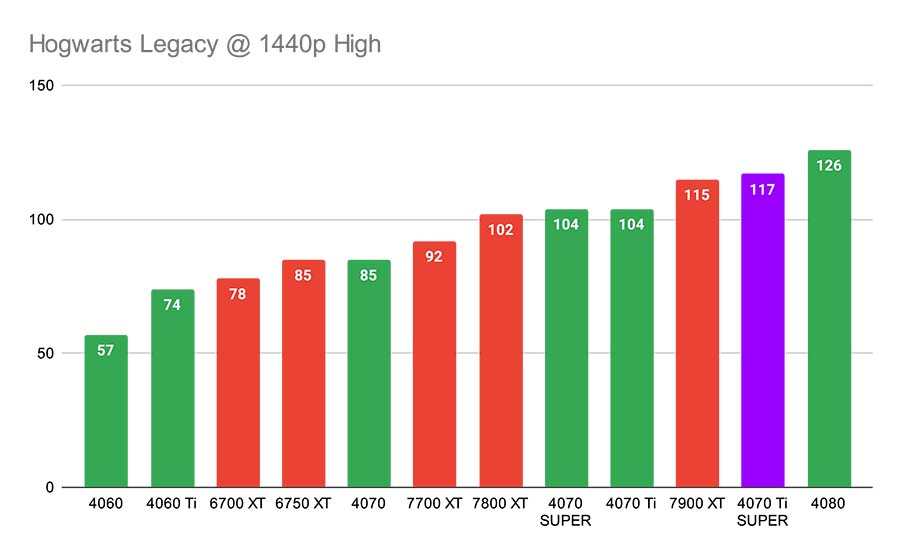
COD Warzone
Settings: 1440p, Upscaling/Sharpening FSR 2.1/DLSS Quality (80 Sharpness), Texture Resolution High, Texture Filter Anisotropic High, Level of Detail High
COD Warzone players can see massive gameplay benefits from higher framerates in this title, and the RTX 4070 Ti SUPER was able to demonstrate just how capable it is. This GPU offered an average of 173FPS, cementing it as one of the strongest graphics cards for 1440p gaming. The performance from the RTX 4070 Ti was well above the 144Hz sweet spot that we love to see with metrics even sitting above the RX 7900 XT again.
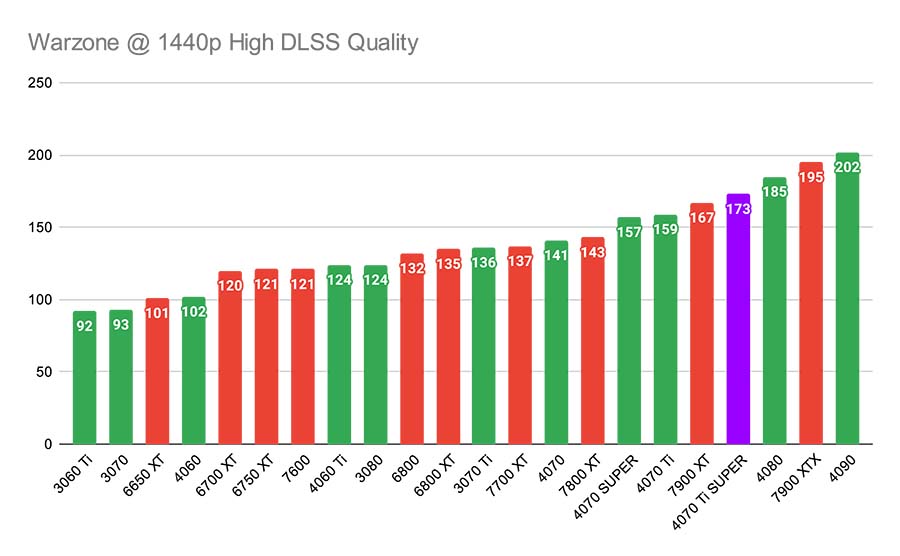
F1 2022
Settings: 1440p, Ray Tracing Quality Medium, Lighting Quality Ultra High, Post Process High, Shadows Ultra High, Weather Effects Ultra High, Ambient Occlusion HBAO+, Asynchronous Compute On, Texture Streaming Ultra High, Anisotropic Filtering 8x, DLSS: Enabled
In our benchmark for F1 2022, the RTX 4070 Ti SUPER offered impressive performance yet again, leading the fore with an average of 284FPS. Admittedly, you’re not really going to notice the difference in framerates here, but gameplay will be more stable. What’s more, you’ll be able to enjoy ray tracing in this game without any major performance hiccups which is great to see.

Apex Legends
Settings: 1440p, Anti-aliasing TSAA, Texture Filtering 8X, Model Detail High, VSync Disabled, Effects High, Ambient Occlusion Quality High
In Apex Legends, the RTX 4070 Ti SUPER offered excellent framerates, surging up to 256FPS on average. The RTX 4070 Ti SUPER sat cemented itself within the high-end space, sitting in between the RX 6950 XT and the RTX 4080. Performance at the top-end within Apex Legends is very close, there’s a small disparity in framerates across these high-end cards, making the RTX 4070 Ti SUPER a strong competitor within this game.
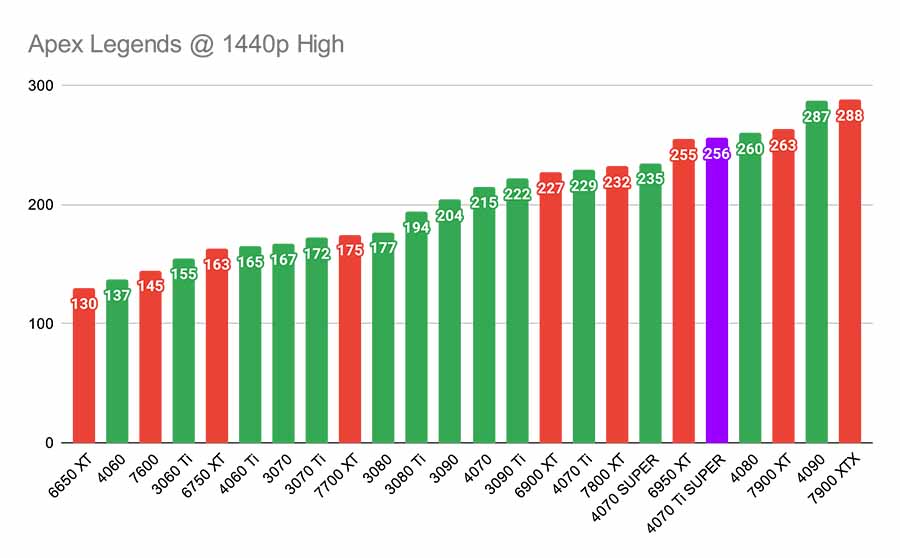
Fortnite
Settings: 1080p, Quality Low, Anti-aliasing & Super Resolution TSR High, Temporal Super Resolution Performance, View Distance Far, Textures Low
Fortnite is still an incredibly popular title within the PC gaming space, so we made sure to include this game within our benchmarking suite by testing performance at 1080p competitive settings. This gives us an indicator of how far framerates can go, and the RTX 4070 Ti SUPER was able to offer up 315FPS on average, yet again placing it in between the RX 6950 XT and RX 7900 XT.
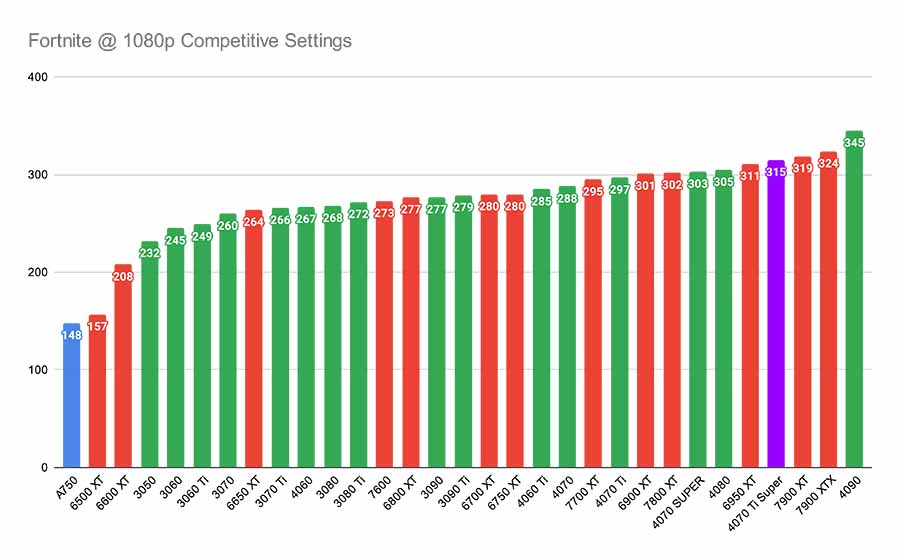
Cost Per Frame
Assessing raw performance is a key metric to take a look at when analysing the value proposition of graphics cards. However, its good to look at the cost per frame to see where this card stands versus the rest of the market. The graphs that we’ve provided below look at the framerate average within Apex Legends and Hogwarts Legacy at 1440p.
Apex Legends
Admittedly, the cost per frame of the RTX 4070 Ti SUPER isn’t as strong versus other cards on the market. With a cost per frame of $3.12, the RTX 4070 Ti SUPER sits above the RX 7900 XTX and RX 7900 XT. This demonstrates that the RTX 4070 Ti SUPER might be a bit pricey when compared to current market alternatives. This is likely to change in more intense games, but within Apex Legends the RTX 4070 Ti SUPER isn’t a cost effective card to pick up.
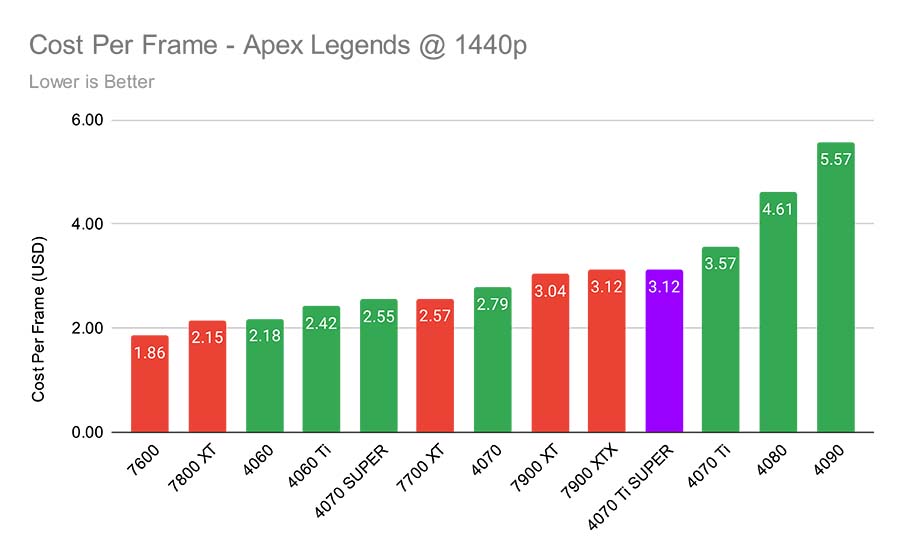
Hogwarts Legacy
In Hogwarts Legacy the cost per frame shifts slightly, with the RTX 4070 Ti SUPER becoming a better bet within this title. Hogwarts Legacy is an intense game, so framerates are pretty close across the board. Despite this, the RTX 4070 Ti SUPER sits towards the mid-point of this graph with a cost per frame of $6.83. Again, this isn’t spectacular, but the RTX 4070 Ti SUPER looks to offer a better proposition within demanding games.
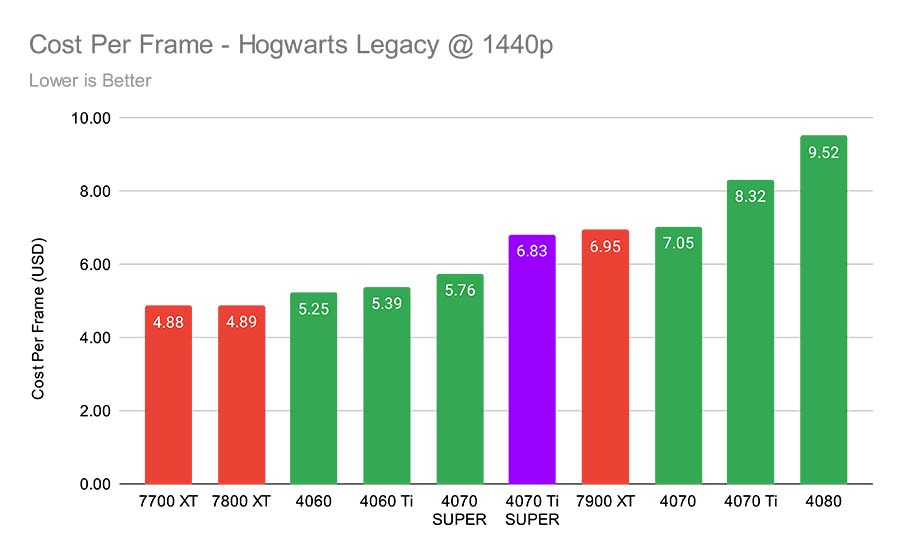
RTX 5000 – Worth the Wait?
The RTX 5000 range of cards is rumoured to launch around Q4 of 2024, or towards the start of 2025. NVIDIA is yet to substantiate any rumours, but in light of the current graphics card landscape, its worth briefly assessing if these new cards are going to be the solid upgrade that buyers are looking to hold out for.
While we’re not in any position to estimate the performance of a potential RTX 5000 set of options. The most recent graphics cards that have hit the market give us an indicator as to where performance might lie with the next generation of GPUs.
Unfortunately, due to the significant performance demands that we’ve seen with the latest games, it isn’t particularly likely that any RTX 5000 cards are going to blow us away. Games have started to shift their requirements massively within the past few years, resulting in even the most top-end GPUs struggling in games like Starfield, Cyberpunk 2077, and Star Wars: Jedi Survivor. For this reason and others, NVIDIA’s codenamed ‘Blackwell’ cards probably won’t dominate when compared to the existing RTX 4000 series.
Now this isn’t all doom and gloom, especially as AMD and NVIDIA’s most recent options are some of the most competitive cards that we’ve seen. But those looking to build a PC should take a look at the existing market and pick an upgrade that fits your prerequisites and budget, as opposed to holding out for a tantalising, yet fleeting dream.
Conclusion
Gigabyte AORUS RTX 4070 Ti SUPER Master
Product Name: RTX 4070 Ti SUPER
Brand: Gigabyte
-
Features
-
Design
-
Performance
-
Value For Money
Summary
Gigabyte’s AORUS RTX 4070 Ti SUPER Master is one of the best performing cards within the RTX 4070 Ti SUPER range. The heatsink size, thermal capability and modest overclock provide boosts to performance that makes this GPU outpace other options. For these reasons, this makes it a worthwhile consideration if you’re dead set on picking up an RTX 4070 Ti SUPER. However, its biggest weakness is its non-MSRP price point.
In a market where buyers are looking for the best value options, manufacturers offering non-MSRP cards are fighting to provide a solid set of features or design aspects that make their card standout above the competition. And while Gigabyte’s AORUS Master variant of the RTX 4070 Ti SUPER does tick most of the boxes, its price is just plainly too high. If you’re the kind of buyer with plenty of extra cash to spare, the Gigabyte AORUS Master version of the RTX 4070 Ti SUPER is one of the best cards within this GPU range. But if you’re a price conscious buyer looking for a solid 1440p capable graphics card, it’ll be worth considering other MSRP alternatives.
Pros
✅ 1440p gaming performance
✅ Solid thermals
✅ Sleek design
Cons
❌ Size
❌ Non-MSRP price
❌ RX 7900 XT as competition


